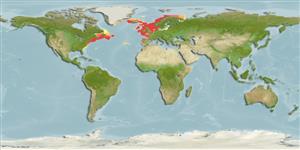Common names from other countries
Environment: milieu / climate zone / depth range / distribution range
Ecología
; salobre; rango de profundidad 0 - 650 m (Ref. 114164), usually 0 - 400 m (Ref. 114164). Temperate; 72°N - 28°N, 81°W - 42°E
Arctic and Atlantic Ocean.
Length at first maturity / Tamaño / Peso / Age
Maturity: Lm ? range ? - ? cm Max length : 52.0 cm WD macho / no sexado; (Ref. 101440)
Epibenthic (Refs. 87524, 95730). Intertidal to subtidal (Ref. 80965). Found in exposed areas with sandy substrate. Predatory; feeds on the blue mussel, Mytilus edulis (Ref. 96377). A ubiquitous, free-living species (Ref. 96391).
Life cycle and mating behavior
Madurez | Reproducción | Puesta | Huevos | Fecundidad | Larva
Members of the class Asteroidea exhibit both asexual (regeneration and clonal) and sexual (gonochoric) means of reproduction. Life cycle: Embryos hatch into planktonic larvae and later metamorphose into pentamorous juveniles which develop into young sea stars with stubby arms.
Harms, J. 1993. (Ref. 2711)
IUCN Red List Status (Ref. 130435)
CITES status (Ref. 108899)
Not Evaluated
Not Evaluated
Human uses
Pesquerías: comercial
FAO - pesquerías: landings | FishSource | Sea Around Us
Herramientas
Más información
Age/SizeCrecimientoLength-weightLength-lengthMorfologíaLarvaAbundancia
Fuentes de Internet
Estimates based on models
Preferred temperature
(Ref.
115969): 6.3 - 10.2, mean 9.7 (based on 19 cells).
Price category
Unknown.
